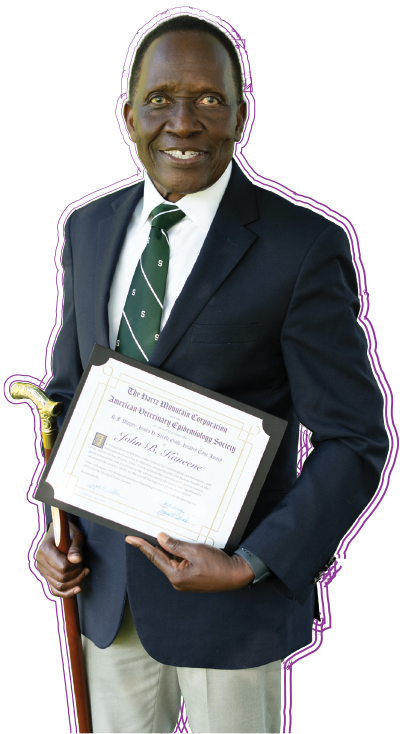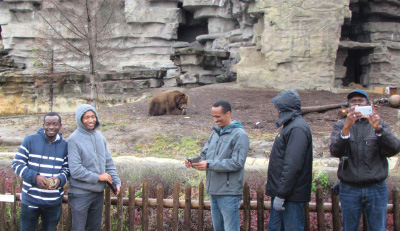

John B. Kaneene, DVM, MPH, PhD, FAES, DAVES, is one of the College’s most seasoned epidemiological researchers and educators. Joining the faculty in 1980, the University Distinguished Professor has put much work into the question first posed to him by his livestock farmer father: “Where does disease come from, and why does it disappear and reappear?” Most recently, Kaneene has been investigating PFAS exposure in companion animals in Michigan and zoonotic diseases in Africa. Not only that, but his work heavily relates to public health and international diplomacy, for which he has been recognized nationally. He has initiated exchange programs that have strengthened MSU’s relationship to multiple countries in Southeast Asia and across Africa.
This spring, Kaneene describes four major projects occupying his time.

One of Kaneene’s biggest projects is a US Department of Agriculture-supported faculty exchange program that exposes international educators to Michigan State. Ten junior faculty from overseas universities are paired with Spartan mentors to observe teaching and research methods over four months.
“We match each of them to somebody who is doing similar research to accomplish five things,” explains Kaneene. “First, they come to see how we teach and evaluate our students. Second, they learn more research techniques. Third, they learn about US veterinary medicine organizations, like the MVMA and AVMA. Fourth, they learn about US animal agriculture. And fifth, they want to learn about US culture.”
Much of this cultural and intellectual exchange takes place on campus: in labs, classrooms, and faculty offices. But just as important are the offsite trips, which range from farms and ranches to living rooms to share Thanksgiving turkey and watch football.
Over the years, several MSU faculty have, in turn, visited their colleagues across the Atlantic in countries that include Kenya, Uganda, Tanzania, Ethiopia, Nigeria, Ghana, Malawi, South Africa, Thailand, Vietnam, India, and others. Visits in either direction provide valuable networking opportunities that form the bedrock for future grants, research, and international collaborations.



An alumni favorite and a food review
A longtime Spartan favorite along Grand River is Thai restaurant Taste of Thai. According to Kaneene, this East Lansing classic is international student-approved as well. “They like it a lot! They say the food in the north, south, and middle of the country varies slightly, and Taste of Thai has food from all regions.” For true authenticity: visiting Thai students often bring ingredients from home to cook for their US hosts.

Every summer for more than 20 years, the College of Veterinary Medicine exchanges veterinary students with Chiang Mai University in northern Thailand. The students from Chiang Mai take three clinical rotations at the Veterinary Medical Center, where observing medicine in a new setting shows them fresh perspectives and approaches.
“The students select their rotations—cardiology, imaging, radiology, etc.,” says Kaneene. “Each is paired with an MSU student, who have been wonderful. They invite [the visiting students] to their homes; it’s been a very good, successful program.”
Students from Thailand are particularly interested in how to establish and operate small animal private practices, as well as biosecurity practices on swine, dairy, and poultry farms.
In Michigan, Kaneene and collaborators are evaluating companion animals as flags of human and pet exposure to the “forever chemical” PFAS in Michigan households. In addition to MSU, this work is supported by the Michigan Animal Health Foundation.
“We’re working in the same households in which the Michigan Department of Health and Human Services is conducting its studies,” he explains. “We will be investigating the primary sources of exposure to PFAS among dogs and cats, comparing their serum PFAS levels to that of their human counterparts—and the outcomes of such exposures, enabling us to determine the suitability of using companion animals as sentinels for human exposure.”
Kaneene’s team also plans to work with clinics to collect blood, household dust, feed, and water to investigate contaminants.
“The outcome of the study could lay the foundation for the development of a syndromic surveillance system using dogs and cats as sentinels,” he says. Such a system, and the results of the study, could have enormous benefits to both animal and human health.
“It’s becoming a real issue,” says Kaneene. “In pets, some of the primary results indicate PFAS may be causing thyroid, liver, and kidney issues.”
Outside of the US, Kaneene is conducting research in Tanzania and Uganda.
The work in Tanzania focuses on a One Health approach—one that takes a holistic understanding of animal, human, and environmental health. He is part of a team studying zoonotic diseases in livestock farmers in the northernmost region of the country.
In Uganda (his country of origin, where his family farmed livestock), Kaneene is involved with investigating the epidemiology and mechanisms of antimicrobial resistance in dairy cattle and poultry. 